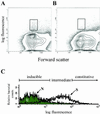Complex pattern of Mycobacterium marinum gene expression during long-term granulomatous infection
- PMID: 11891270
- PMCID: PMC122624
- DOI: 10.1073/pnas.002024599
Complex pattern of Mycobacterium marinum gene expression during long-term granulomatous infection
Abstract
During latent infection of humans with Mycobacterium tuberculosis, bacteria persist in the asymptomatic host within granulomas, organized collections of differentiated macrophages, and other immune cells. The mechanisms for persistence remain poorly understood, as is the metabolic and replicative state of the microbes within granulomas. We analyzed the gene expression profile of Mycobacterium marinum, the cause of fish and amphibian tuberculosis, during its persistence in granulomas. We identified genes expressed specifically when M. marinum persists within granulomas. These granuloma-activated genes were not activated in vitro in response to various conditions postulated to be operant in tuberculous granulomas, suggesting that their granuloma-specific activation was caused by complex conditions that could not be mimicked in vitro. In addition to the granuloma-activated genes, the bacteria resident in granulomas expressed a wide range of metabolic and synthetic genes that are expressed during logarithmic growth in laboratory medium. Our results suggest a dynamic host-pathogen interaction in the granuloma, where metabolically active bacteria are kept in check by the host immune system and where the products of granuloma-specific bacterial genes may thwart the host's attempt to completely eradicate the bacteria.
Figures




References
Publication types
MeSH terms
Substances
Grants and funding
LinkOut - more resources
Full Text Sources
Other Literature Sources
Medical

